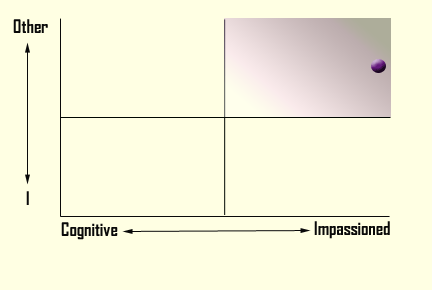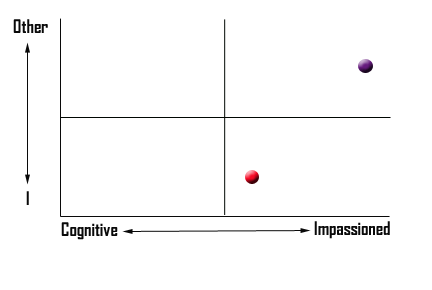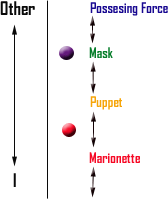So here I’m going to talk only about the upper right block, the domain of the Impassioned Other, where I spend the most and best of my play.

As I’ve mentioned before, I’m a strong masker. I maintain a distinct identity within the characters I play, but I have a powerful empathic connection with the character. I funnel my influence over the game through the agency of the character. I am influenced and informed by the character as a conceptual model, but because I can still maintain a sense of the character as a conceptual model, I can also assert influence over its development (with time and context) without denying my payoff. I willfully give the character a measure of transformative power over me as a goal of play, and for me, that transformation equals my cathartic goal.
All of these things are only fueled forward by my strong preference for impassioned play. Funneling decisions and actions holistically and intuitively via the character within the emotional milieu of the story and the character’s context in it optimizes the cathartic connection (open the floodgates!) and works to constrain any cognitive dissonance that might interfere with the empathic connection to character.
So, as you might imagine, out here where I play can be a really vulnerable place to be. There is a direct conduit between my emotional centre and the experience of the character, and I heavily invest in that empathic conduit. I feel things that my character feels as emotionally acutely as if I was the character, and although I maintain some degree of distinctive identity from the character, I am deeply affected by her plight even in situations where I personally do not agree or sympathize with her. When the games I play are the best that I can ask for, I have not just invited the game into my emotional centre to mess around, I have in fact, demanded that it do so.
Like Brand mentioned in his article on danger, some people would call this behavior in a game “dangerous play” or “edge play” because it is a willfully vulnerable state, and could possibly end up in the player getting hurt (I.e. psychologically or emotionally damaged, not “hurt feelings”). This is not what I consider “dangerous play” nor “edge play”; for the most part, it’s just “play”. I rarely get hurt in a game, but if I do it’s not because of this process, but because I’ve chosen to play in dangerous territory, with issues that I know are triggers or grey zones for me. Even then, because of the way I set up games, I don’t ever really get hurt, I just get shaken, and need a period of recovery (If people want, I can talk about this in a separate post, but I don’t want to go any farther here for fear of getting off topic).
However, the point is, that it is a vulnerable place to play, and that the structure that is required to support that vulnerability never happens incidentally. It requires a considerable amount of personal and emotional intimacy, both with the other players in the game and with the character & the story to make work. So I’m going unpack each of these individually for a bit.
In the post before last, I gave you an overview of My Gaming Census. The reason I needed that was to help explore how my gaming environment contributes the level of intimacy required to play where I play. I don’t think it’s necessary to go through each of the following and expedite how they might foster the kind emotionally intimate environment that would help somebody feel supported in being vulnerable in a group activity. So I’ll just repeat some key census data here:
- I’ve known the people I play with for, on average, 10 years.
- One of the people I play with most often is my husband.
- I socialize with almost all of them more frequently than I game with them
- I’ve been to all of their weddings, took care of their property, pets and/or kids. (and vice versa).
- I know them all well enough to list that data off the top of my head.
- We’ve played in intensive, high emotional, epic games with each other for years.
And a few more that might be suggested by the ones above but that I want to make explicit:
- We’ve adjusted our play groups, meeting times and locations for game around, vacations, pregnancies, life events and baby raising.
- We have had a thousand discussions on what we like and what we don’t like.
- We’ve had a thousand wicked play experiences, and some really big play disasters.
- We cook together, eat together, mind babies together, and clean up together, usually all in and around a game session.
And there are three things that I didn’t go into on the census. The first is that the more we play, the better, and more intentional our social contracts have become. Most of my games these days are based on IWNAY. Some are NGH with lines as clearly defined as possible. These clear policies help to define the boundaries at the table, or to mandate the expectation of support when things go badly, and strengthens the trust around the table.
The second, is that we make common use of ritual in our games. Each long running game has its own soundtrack, often has a theme song, has repeated key lead-in phrases, and environmental cues like incense or candles to help transition into and out of a protected space.
The third is that the majority of people that I play with are also Impassioned players, and a good chunk of those are Impassioned Others (notably, I believe, all of the women). While we are all not following precisely the same process or seeking precisely the same payoff, our shared preferences help us understand each other’s needs in the game, and so, for the most part, things in this area are pretty well protected (I by no means intend to say that my gaming group does not ever face obstacles or challenges, it’s just that in general we’ve done these pretty well, IMHO).
The second kind of intimacy that is (mostly) required to play where I play is an emotional intimacy with the character and the story. The answer to securing this one is usually just time, energy, and focus. For me and the majority of people I game with, emotional investment into the character and/or story compounds over the time played. It’s very rare for me to be able to plug in to a character immediately and have enough investment to seat in an emotional context and achieve the cathartic payoff I’m looking for. Sometimes it takes whole sessions to find, sometimes I get glimpses of it, sometimes it stutters in and out (Vincent, if you’re reading this, I’ve had more success in seating out the gate with Dogs than with any other game I’ve played).
However, in a long-run campaign, it’s rare that I don’t slide right into the emotional context of a character as soon as we start, even if it’s been a while since we’ve played a game. This is also a reason why “time lapsing” is disruptive to me in games. By that, I’m not implying any particular lapse of time, but instead a lapse over a critical period of time, whether that is 1 day or 100 years. In Exalted, if we just finished a plotline in which a sense of closure was achieved, skipping 100 years probably wouldn’t be a problem. However, if we skipped a day or week in the life of the same character where no closure had been achieved, I might have trouble with engaging the emotional context of the character. The same goes for the story.
And since this has turned into a really long post, I’m going to start to wrap up. The whole article is meant to say that playing where I play takes certain support parameters (as I am sure do many areas on the grid, especially along any given perimeter) and to explore the kinds of support my group employs. Also, this post has been meant to say that if you don’t recognize my play style, one possible reason could be that you just don’t encounter it. If your main source of gaming is pick-up play, convention play, or (tabletop) play in a public space, it’s possible that the environment is not conducive to people who play like me.


